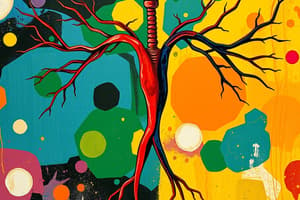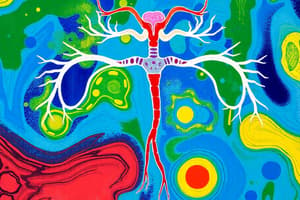Podcast
Questions and Answers
What hormone plays a crucial role in regulating bleeding after childbirth?
What hormone plays a crucial role in regulating bleeding after childbirth?
- Estrogen
- Follicle-stimulating hormone (FSH)
- Oxytocin (correct)
- Progesterone
Which gland is directly controlled by the hypothalamus to regulate hormone release?
Which gland is directly controlled by the hypothalamus to regulate hormone release?
- Thyroid gland
- Adrenal glands
- Pituitary gland (correct)
- Pancreas
Which of the following is NOT a function of oxytocin?
Which of the following is NOT a function of oxytocin?
- Regulates blood sugar levels (correct)
- Contributes to feelings of bonding and social attachment
- Stimulates uterine contractions during labor
- Promotes milk ejection during breastfeeding
What is the primary function of the pituitary gland in the endocrine system?
What is the primary function of the pituitary gland in the endocrine system?
The hypothalamus's control over hormone release from the pituitary gland is an example of what type of feedback loop?
The hypothalamus's control over hormone release from the pituitary gland is an example of what type of feedback loop?
Which of the following is NOT a function of the kidneys in metabolism?
Which of the following is NOT a function of the kidneys in metabolism?
The kidneys are essential for maintaining the body's internal balance. What term describes this balance?
The kidneys are essential for maintaining the body's internal balance. What term describes this balance?
What is the primary function of the process called catabolism?
What is the primary function of the process called catabolism?
Which of the following is an example of a metabolic process that occurs in the kidneys?
Which of the following is an example of a metabolic process that occurs in the kidneys?
What percentage of energy released during catabolism is not captured by ATP?
What percentage of energy released during catabolism is not captured by ATP?
Which of the following statements accurately describes cellular respiration?
Which of the following statements accurately describes cellular respiration?
Which of the following is NOT a product of cellular respiration?
Which of the following is NOT a product of cellular respiration?
Which of the following is a key difference between aerobic and anaerobic respiration?
Which of the following is a key difference between aerobic and anaerobic respiration?
What is the role of insulin in regulating blood glucose levels?
What is the role of insulin in regulating blood glucose levels?
Which of the following is a characteristic of diabetes?
Which of the following is a characteristic of diabetes?
What is the lymphatic system's primary role in the body?
What is the lymphatic system's primary role in the body?
Which of the following is NOT a function of the lymphatic system?
Which of the following is NOT a function of the lymphatic system?
How do white blood cells contribute to the immune response?
How do white blood cells contribute to the immune response?
Which type of white blood cells are responsible for producing antibodies?
Which type of white blood cells are responsible for producing antibodies?
Why is the lymphatic system considered part of the immune system?
Why is the lymphatic system considered part of the immune system?
What is the name of the disorder caused by a deficiency of Calcitriol in children?
What is the name of the disorder caused by a deficiency of Calcitriol in children?
Which of the following is a characteristic of Menopause?
Which of the following is a characteristic of Menopause?
What is the primary function of Calcitriol in the body?
What is the primary function of Calcitriol in the body?
Which of the following is NOT considered a side effect of a decrease in female sex hormones?
Which of the following is NOT considered a side effect of a decrease in female sex hormones?
In which scenario would you expect to see a deficiency of Calcitriol?
In which scenario would you expect to see a deficiency of Calcitriol?
What type of cells are present in lymph?
What type of cells are present in lymph?
Which of the following best describes the primary function of the lymphatic system?
Which of the following best describes the primary function of the lymphatic system?
How does the spleen contribute to fighting infections?
How does the spleen contribute to fighting infections?
What is the relationship between lymph and the lymphatic system?
What is the relationship between lymph and the lymphatic system?
How is the spleen involved in the lymphatic system's role in fighting infections?
How is the spleen involved in the lymphatic system's role in fighting infections?
Flashcards
Oxytocin
Oxytocin
A hormone that helps control bleeding after childbirth.
Hypothalamus
Hypothalamus
A brain region that sends signals to the pituitary gland for hormone control.
Pituitary gland
Pituitary gland
A gland that releases hormones directed by the hypothalamus.
Hormone release
Hormone release
Signup and view all the flashcards
Endocrine system
Endocrine system
Signup and view all the flashcards
Rickets
Rickets
Signup and view all the flashcards
Calcitriol deficiency
Calcitriol deficiency
Signup and view all the flashcards
Menopause
Menopause
Signup and view all the flashcards
Female sex hormones
Female sex hormones
Signup and view all the flashcards
Aging and hormone change
Aging and hormone change
Signup and view all the flashcards
Kidneys' Role in Metabolism
Kidneys' Role in Metabolism
Signup and view all the flashcards
Energy Capture in Catabolism
Energy Capture in Catabolism
Signup and view all the flashcards
Fluid Regulation
Fluid Regulation
Signup and view all the flashcards
pH Regulation
pH Regulation
Signup and view all the flashcards
Electrolyte Control
Electrolyte Control
Signup and view all the flashcards
Cellular Respiration
Cellular Respiration
Signup and view all the flashcards
ATP
ATP
Signup and view all the flashcards
True or False: Cellular respiration provides most of the ATP
True or False: Cellular respiration provides most of the ATP
Signup and view all the flashcards
Diabetes
Diabetes
Signup and view all the flashcards
Insulin
Insulin
Signup and view all the flashcards
Lymph
Lymph
Signup and view all the flashcards
Function of Spleen
Function of Spleen
Signup and view all the flashcards
Lymphatic Vessels
Lymphatic Vessels
Signup and view all the flashcards
White Blood Cells
White Blood Cells
Signup and view all the flashcards
Role of Lymphatic System
Role of Lymphatic System
Signup and view all the flashcards
Lymphatic system function
Lymphatic system function
Signup and view all the flashcards
Immune response cells
Immune response cells
Signup and view all the flashcards
Types of white blood cells
Types of white blood cells
Signup and view all the flashcards
Lymphocytes
Lymphocytes
Signup and view all the flashcards
Neutrophils
Neutrophils
Signup and view all the flashcards
Study Notes
SQUAD 1
- Loop of Henle: Composed of thin descending limb and thick ascending limb.
- Liver Location: Right upper quadrant.
- Kidney to Bladder Connection: Ureter.
- Urethral Sphincter: A voluntary muscle (True).
- Digestive Hormones: The digestive tract signals for hormones related to hunger ("Hungry") and fullness ("Full") (True).
- Pituitary Hormones: The pituitary gland secretes 9 hormones.
SQUAD 2
- Hormone Classification: Three types: amino acid derivatives, peptide hormones, and lipid derivatives.
- Postpartum Hormone: Oxytocin helps control bleeding after childbirth.
- Hypothalamus Function: Sends signals to control hormone release in the endocrine system.
- Type 1 Diabetes: Characterized by insulin resistance in the pancreas.
- Heart Hormone: The heart releases a secondary hormone.
METABOLISM AND ENERGETICS
- Metabolism Definition: The process of energy transformation in the body.
- Metabolism Goal: To balance energy production and usage.
- Anabolism Function: Creates new molecules for growth and repair.
- Catabolism Molecules: Breaks down fats, carbohydrates, and proteins.
- Liver Function: Detoxifies harmful substances (True).
- Kidney Function in Metabolism: Regulates fluid, pH, and electrolytes.
- ATP Capture: 40% of energy released during catabolism is captured by ATP.
CELLULAR RESPIRATION AND DIABETES
- ATP Source: Cellular respiration provides most of the ATP in cells (True).
- Metabolic Disease: Diabetes is a metabolic disease where the body does not produce or use insulin properly.
- Mitochondrial Disease: Involves the inability of mitochondria to generate energy.
SQUAD 4
- Mitosis Phases: PMAT (Prophase, Metaphase, Anaphase, Telophase) are the four phases of cell duplication.
- Atom Components: Proton, neutron, and electron.
- Muscle Tissue Types: Skeletal, cardiac, and smooth.
- Stable Molecules: Covalent bonds form when molecules share electrons.
- Molecule Definition: One or more bonded elements form a molecule.
- Lymphatic System: A fluid (lymph) containing white blood cells that circulates through lymphatic vessels.
- Spleen Role: Filters blood and fights infections.
- Lymphatic System Function: Maintains fluid balance and protects against infection.
- Immune Response Cells: White blood cells are primarily involved.
- Lymph Nodes Role: Filter lymph and trap pathogens.
- T-Cell Function: Attack infected cells.
- Tonsils Function: Trap and remove pathogens entering the throat.
- Lymphatic Vessels Function: Collect and transport lymph.
- Lymphedema: Swelling due to lymph accumulation.
- Thymus Role: Maturation of T cells.
Studying That Suits You
Use AI to generate personalized quizzes and flashcards to suit your learning preferences.



